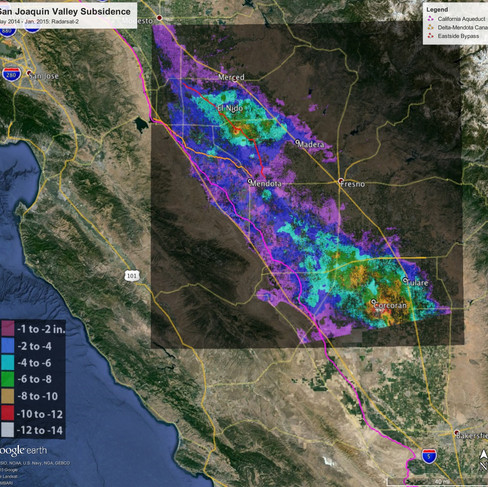Local land sinks further as farmers underuse MID
- John Rieping
- Feb 25, 2017
- 3 min read

John Rieping/The Madera Tribune
Madera Irrigation District staff and board members look at a map Tuesday showing which parcels of land with access to canal water used it during the 2016 water season and which did not.
Western part of county undermined by overpumping of groundwater Parts of western Madera County have sunk as much as 12 to 16 inches in 2015-2016, according to NASA. Yet 47 percent of farmland with access to Madera Irrigation District water didn’t use it.
MID General Manager Thomas Greci showed a district water usage map for the 2016 water season, which ends Tuesday, during the district’s board of directors meeting this week. The color-coded map resembled a patchwork quilt, revealing that many local farmers apparently chose to fallow land or pump groundwater rather than access MID canal water.
“That is very powerful in showing that there’s just a handful of growers, a lower percentage, actually taking the (available surface) water” for irrigation, Greci commented. “So we want to get everybody taking water.”
Groundwater pumping amid the state’s drought has caused record land subsidence in the San Joaquin Valley, particularly near Chowchilla and Corcoran, according to a 2015 NASA report for the state’s Department of Water Resources. Another NASA report, released earlier this month, showed those two main areas of subsidence had grown wider and deeper between May 7, 2015, and Sept. 10, 2016. A third, new subsidence area was detected in Fresno County, near Tranquility, where land had sunk up to 20 inches.
Each bit of elevation lost is a permanent drop in the water-storage capacity of the underground aquifer.
Normally groundwater pumping provides only about 30 percent of the state’s fresh water supply, according to a 2010 study by the state Legislative Analyst’s Office, but in dry years this increases to about 40 percent statewide as surface water — from rainfall and snowmelt — is less available.
That shouldn’t be the case this upcoming water season in which water should be relatively abundant due to winter storms. “Right now it looks like we will be going into next season with an uncontrolled season,” Greci told board members Tuesday, “so we’ll have access to our contract totals, trying to move as much as we can. There will likely be Class II water available (from Millerton Lake through Friant Dam). They’re looking at middle of June for that.”
A minority of growers were taking MID water to flood land for the sake of helping recharge aquifers, but demand melted away with the rain this past month.
“The ground’s just so saturated right now,” Greci said. “Growers are starting to get interested in spraying and doing other activities … (We hope) to move some more water very soon, but we will continue to just keep the basins full for recharge purposes, and any other opportunities we have to turn on (water distribution) we will do that.”
MID has been able to recharge more than 2,500 acre feet of water in its basins over the past two months – returning that water to the area’s underground aquifer. “That’s just tremendous. That’s great for us,” said district engineer Sean Smith.
Greci said staff has also “been pushing water anywhere they (safely) can in the (water distribution) system, just using our system as a big return basin.”
Doing so has been a challenge amid storms that have uprooted and washed down dead vegetation from the banks of long dry riverbeds.
“It’s been a lot of fun the last three weekends in a row with all these creeks running over everywhere ... We were able to fight some of this trash in some of these weirs and these creeks,” said Charles Contreras, MID operations and maintenance manager. “The first two storms were pretty rough. The last one we had was last week and it wasn’t too bad. I think everybody pretty much cleaned out a lot of these creeks. We still had Cottonwood Creek that was actually running pretty heavy still down here.”
The welcome but challenging weather may have nearly ended the region’s six-year drought. The U.S. Drought Monitor said Thursday that most of Madera County was only abnormally dry, and the rest of the county was not experiencing any degree of drought at all.
That doesn’t mean all is normal however. Locally and elsewhere in the San Joaquin Valley “wells were still in jeopardy and groundwater aquifers will take many more weeks or months to recharge,” wrote Richard Heim of the National Oceanic and Atmospheric Administration / National Centers for Environmental Information.
Greci said MID would focus its annual growers meeting, set for April 26 at Hatfield Hall, on educating local “growers on why it is important to use this surface water when it is available to us.”
Legally, California remains in a drought emergency declared by Gov. Jerry Brown in 2014.






























Comments